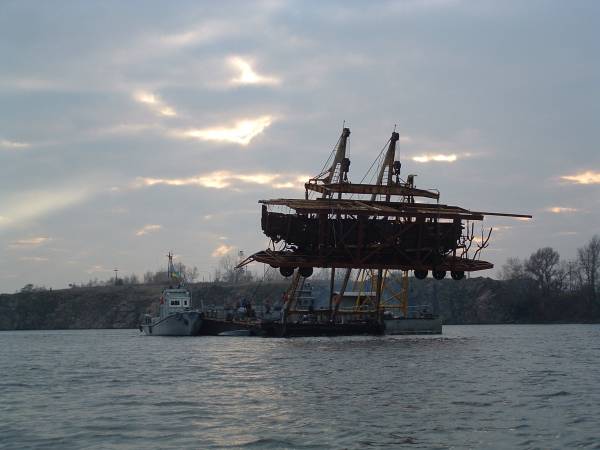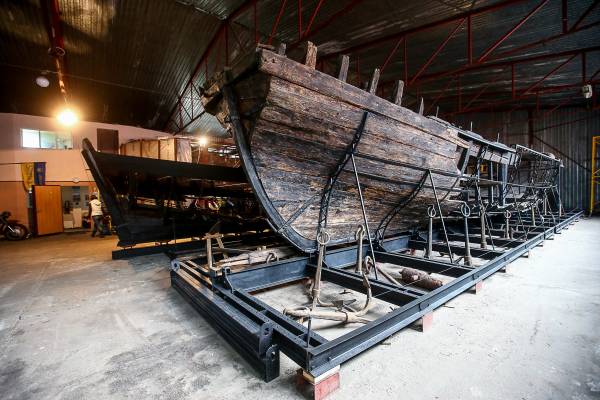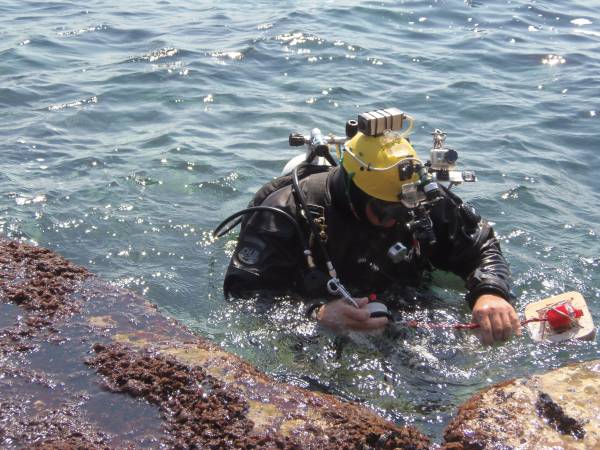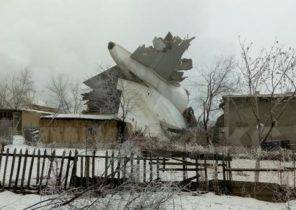
“Sanguinosa, Bo mi that part”, — the saying has invested all the pride of the Ukrainians for their people. “Pride in hard work, resilience in the face of the enemy, devotion to his native land. Here and self-respect, and a little cunning, and resourcefulness — Ukrainian character is multifaceted, says folklorist Les Naumovski. — This unique code of a nation is passed from generation to generation.”
One of the elements of this code — the story, in fact it is the basis of identity of the nation. And sometimes to explore the story have recourse not only to books but also to a diving suit, after all, a lot of interesting hides the water surface. What unique things at the bottom, we told the head of Department of protection of monuments of the National reserve “Khortytsya” in Zaporozhye Dmitry Kobalia. Underwater archaeology — his longtime passion. In third grade, our hero, along with other enthusiasts of the archaeological club, researched the ancient settlement.
“Under the water I walked just after 9 years, — says Dmitry. At that time the vestments of the Soviet-fashioned diving suit took more time than the dive. But the excitement of the seeker was stronger than all the inconvenience! Because underwater excavations — archaeology is the same. Underwater historical artifacts no less than under ground.”
Currently known the most valuable artifacts in Ukraine, was found under water, are of the Cossack “the Seagull” during the Russo-Turkish war, “Brigantine” — the participant of war with Sweden, the skull of a mammoth, found at the bottom of Aurelie, silver “sword of Svyatoslav”, caught by a fisherman from Zaporozhye, and many antique finds. The only well-preserved ancient merchant ship — “snake Patroclus” — found the team of Alexander Tereshchenko from the Odessa club “Novarex”. Many valuable exhibits in many museums of Ukraine were found enthusiastic divers that is at the bottom of ponds. Archaeologists believe: underwater Ukraine still surprise us with their secrets…
“The archaeologists are divided into several types, says diver, archaeologist and head of Department of protection of monuments of the National reserve “Khortytsya” in Zaporozhye Dmitry Kobalia. — There are “collectors” — they are looking for specific items. Separate history — “necrophilia”: they do not feed bread — let me go digging in cemeteries, burial mounds, graves. And the third category to which I consider myself — the catchers of time: we are driven by the pure desire to touch the artifact, which hundreds, if not thousands of years.”
The chance to find artefacts under the water is very high, especially in those places where significant historical events. But first it is necessary to work with items already found and documents (records of local historians, the diaries of participants in the events, Chronicles): they have much to tell and help to determine the promising search space. Denoting the map findings, searchers get a picture of the location of potential artifacts. Of course, the search takes time: it is 60-70% of the work of professionals. Therefore, for many archaeologists — both land-based and submarine — so valuable “field” journals.
“Similarly, the new archaeological school — often occurs around a monument, exploring which new generations bring to the work something new, explains Kobalia. but many are searching under water “at random” — and sometimes find no less valuable finds, than those who act “on science”. Often Antiques find close to the shore, and having the experience and a certain skill, “submariner” through the glass of the mask immediately makes an interesting discovery.
Such finds divers have accumulated a lot. So why not create in Zaporozhye, won the largest number of underwater artifacts, underwater Museum, providing tourists with the equipment, conduct of excursions directly under the water? For example, in Odessa there are similar: the eyes of the people in scuba gear brought the figures of famous personalities of Soviet history, a massive old anchor, targets for spearfishing. And the Museum of underwater shapes in cancún has become a real tourist highlight.
“Unfortunately, the culture of relations to underwater monuments yet in its infancy, — says Dmitry. — Many underwater deposits located at a depth of 50 m, looted black archeologists. Their findings are often heard in private collections, and could be a decoration of any Museum.”
DIVERS: FORGET THE FLIPPERS
“Plunging every day, in fact, working on the machine, — says Kobalia. Different happened: one diver forgets to wear flippers, the other suit to zip up… there was a case when a diver went to sleep under water! During operation of the ejector ran out of fuel, and while I poured a new batch, people waiting under the water, zakemaril. Earned the ejector woke him up, otherwise things could end bad…” And sometimes in the raised ships find the axes, planes and other carpentry supplies then shipbuilders.
MAKAREVICH: CONVINCED A SPONSOR TO GET A “BRIGANTINE”
When archaeologists dug up the “Seagull” far from it was discovered and Brigantine. “This ship is much overall, — says Dmitry Kobalia. — 18 meters long, 5 meters wide. Such ships appeared in the Swedish war under Peter I, and was based on the Italian Brigantine. 30 years later they began to build on the Dnieper”.
In 2004, “the Brigantine” it was decided to raise — although this ship was a lot more damage and lay on its side, crushed by own bottom. The ideological inspirer of the project was Andrei Makarevich, he has plunged to “Brigantine” and convinced one oligarch to sponsor raising. But he set a condition: the vessel must be whole — to be more presentable. So, “the Brigantine” is needed, as the designer, to collect even under water!
“All this time the leader “time Machines” often came to us, dived to the artifact, — says Dmitry. But when only visits Makarevich stopped, disappeared, and funding. To raise from the bottom of the ship we had, but on the restoration and conservation of money left. So while Brigantina remains in the same state.”

“Brigantine”. Musician dived to the vessel together with the archaeologists. Photo: K. Ermolaeva
AS HE RAISED A CUP OF TEA: HELPED THE PRESIDENT’S VISIT
Once Dmitry Kobalia team found at the bottom of the stern of a wooden ship. It was the legendary “Seagull” — type of submarines built for the Russian-Turkish war (1735-1739) with the direct assistance of the Cossacks: they knew the secrets of the rapids of the Dnieper, and thus could design the perfect ship.
“The whole year we were preparing for the raising of “the Seagull”, were looking for sponsors, — says Dmitry. — Periodically immersed in this place, and after another discharge of water suddenly loomed some more of the buildings! It became clear that the lifting of all detected ships will need a lot of time. In 1999 he was raised to the surface of the first Cossack boat. In the study area, to raise the ship, was given just a month we managed to right the visit to Kiev by the then President Leonid Kuchma.”
Only the operation of the ejector (pump), bilge bottom, left
up to two hundred litres of fuel a day! In addition, each element finds the divers sketched on a special tablet… right under the water. Special photo and video cameras, the team was not. All found described and documented, for a more accurate picture of the reconstruction. Then for work was taken technicians: they needed to make an accurate analysis, and despite the wind, cold and rain.
When it became obvious danger that the fragile from the time the case can crack when picked up, it was decided from the bottom to embrace a kind of “towels”. “The divers then took a big risk, says our hero. In the darkness, surrounded on the sides by soil and above — body of the ship, they dug under the already freed the ship with a dozen holes.
Time was running out, we slept for a few hours a day, wore not had time to dry wet suits and plunged again… In the end, “the Seagull” was brought to the surface in time! But local officials seem to not really believed in us and just… excluded from the program of the visit, Kuchma’s presentation of the boat.
The adventure of “the Seagull” has not ended. For a long time it was exhibited near the place of raising. To save wood, the boat is watered and treated with chemicals. Then a 17-metre ship were transported to the area of the equestrian theatre in Zaporozhye. Months later the ship was under the open sky, where his conservation took 11 tons of special substances. But over time, “the Seagull” found her hangar, and in 2008 underwent a full restoration. This started with the study of shipwrecks in the waters of the Khortytsia”.

“The Seagull”. On the preservation of the ship went 11 tons of special substances. Photo: K. Ermolaeva
SNAKE: ISLAND OF LOST SHIPS
In the Odessa area, literally 35 km from the coast, is the snake island is one of the most interesting and promising places on the underwater finds in Ukraine. Here it was discovered unique artefacts, spanning the period from ancient times until the Second world war. BC there was a sanctuary of Achilles, so for scientists, the island has long been a “tasty morsel”, to investigate which in Soviet times was impossible: the Snake was located closed base defense. And only since 1988, the study Islands were carried out by the team of researchers — public organization “podvodno-archaeological expedition “Novarex”.

On the search in the waters o the snake. It looks like the diver-archaeologist in full working gear. Photo: From the archives of the club “Novarex”
In 25 years of studying the waters of the island, the researchers were at the bottom of tens of kilometers. Where artifacts could not be seen, used instrument search. Titanic work of underwater archaeologists were successful: in the Black sea was discovered the destroyer of the First world war, the submarine “Pike” the Second world war, a merchant ship of the late eighteenth century, four places the death of wooden ships, more than a hundred (!) antique stone and lead anchors and a lot of pottery.
And in 2011, the scientific world had spread sensation: found antique shopping sailing vessel of 24 m in length and 8 m in width. The ship “snake Patroclus” (so dubbed discovery) has become a real jewel among the other wrecks of the island. What is unique about this finding? “In world practice identified three objects of the IV century BC, explains a member of the expedition “Novarex” Alexey Ivlev. But, unfortunately, they are very sacked and do not give a complete picture of ancient Maritime trade. The uniqueness of a sailboat is found in its excellent condition for vessels of that period: analogues of the object “snake Patroclus” according to the degree of safety in the world not found”.
Well preserved and contents of the artifact — ship all sorts of utensils, galley equipment, black lacquer ware on sale and about a thousand amphorae. On the raising, preservation and exhibition of the “Patroclus” required a lot of money, so the ship still rests on the seabed. And his location strictly secret to avoid looting of black archeologists.

“Patroclus”. Model sailboat antique shopping. Photo: From the archives of the club “Novarex”
DUBEL-BOAT: THE MONEY WAS PROVIDED BY THE U.S. EMBASSY
“Today in our hangar four vessels, — says Dmitry Gordo Kobalia. — Apart from gulls and the Brigantine has a unique Dubel-boat. In 2010 she was raised and restored thanks to the financial support of the U.S. Embassy. The ship was badly damaged, but we have recreated the original state of the frame and set it all preserved.
In the same year from the Gums pulled a 12-foot punt. It is the youngest instance of our collection, built in the early XX century”.
In all, over 40 years of underwater work in the area of Khortitsa was found many artifacts. For example, in the stern of one of the first discovered underwater gulls was an iron Cossack boiler with rivets, and a large wooden spoon. Inside the boat was the stern lantern with mica instead of glass, ship tools, cast iron core, two guns with mark “Kiev 1734”, Tula rifle. Well-preserved buttons, bronze buckle, a fragment of the woolen clothes and even leather boots.
MANUAL OF CATFISH AND A STOLEN LADA
According to the experienced divers, often actors searches are… fish! “Sometimes, immersed, working on the ejector, suddenly swims a flock of carp and starts to play with you — well, just like children! — laughing is our hero Dmitry Kobalia. — Bulls — the more serious guys: line up in rows like spectators in the theater, and begin to carefully observe what is happening. And “Brigantine” we had even hand-som — apparently lived on the sunken ship. Every morning this beauty greeted us under water, allowed himself to stroke, feed and even twitch his mustache. And we protected him from stray predators”.
One day divers found in the river the place where in Soviet times dropping case of stolen car: dozens of “Zhiguli” has found here last shelter!
Happen modern miracles: some divers find underwater things, lost a few years ago.







